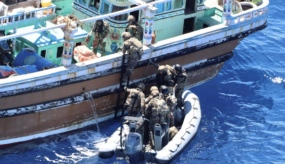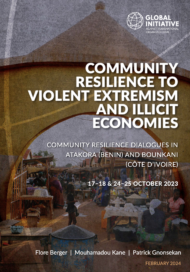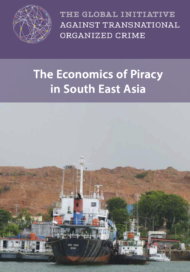Posted on 27 Dec 2013
Abajo la versión en español
The boat was packed. Five hundred men and women were on board, hailing from Ghana, Somalia Eritrea, and a kaleidoscope of other countries. Sailing north from the Libyan coast the boat was within sight of its destination when it began taking on water, and then capsized. While coast guard vessels rescued some of the migrants, few knew how to swim. The bodies floating in the surf off the Italian island of Lampadusa were a grim reminder of the desperate journey many embark on for a better life, and the often-fatal dangers they face.
While migration is no crime, the challenges of negotiating complex immigration or asylum procedures in destination countries, or transiting the complex geographical routes across inhospitable terrains leads many to seek the assistance of smuggling groups to help them navigate their passage. As a consequence, migrant smuggling is becoming all pervasive in the modern world. Migrant smuggling denotes a situation in which an individual willing contracts with a third party to be transported into another country without having formal documentation or consent to enter that country.
The demand for illicit migration is driven by the economic discrepancies between the developed and developing world. The salaries of Europe, the U.S., Canada, and Australia far higher than what can be earned in many developing countries. For millions of young adults facing bleak job market in low-income areas of Africa, Latin America, and Asia, the most viable way to achieve financial success is to engage in a risky, and often unsuccessful migration to the developed world. Others, fleeing from war or oppressive governments, may have little choice but to migrate and hope for the best.
Specialized migrant smuggling organizations have arisen to cater to this demand. The market is lucrative, generating more than $6.75 billion annually for the groups involved. Migrant smuggling is often facilitated by a vast number of different groups, each specializing in moving people through one distinct geographic area. Some of the gangs are highly complex, able to supply doctored passports or maintain fleets of migrant smuggling vessels. More frequently, the smugglers are minimally organized and low tech. Successfully moving someone across a land border requires an intimate knowledge of the territory and the operational habits of border guards, creating a low bar for prospective migrant smugglers who live alongside an international border.
The largest flows of illicit migrants move via two well defined corridors: from Central America into the United States, and from Africa into Europe. The Latin America-US corridor is one of the most well-traveled illicit migration routes in the world. Migrants, mainly from Mexico, Central, and South America, along with smaller numbers of Asian and African migrants, attempt to cross Mexico’s border with the U.S. in areas that are remote yet have access to roads. Historically most the migrant smugglers in the area have been small, locally based organizations. This has shifted over the last decade, as Mexico’s powerful drug trafficking organizations have moved into the market. The UNODC Global Threat Assessment estimated that this high traffic route may be used by upwards of three million migrants every year.
The other large migration corridor extends from Africa to Europe. Routes extend from sub-Saharan Africa either across the Saharan desert and on to the North African Coast, or to the West African coast. At either of these end points, the smuggled migrants face a daunting sea voyage. From West Africa, migrants attempt to reach Spain’s Canary Islands. From North Africa, migrants attempt to cross the Mediterranean, often aiming for Italy. Historically, the number of migrants smuggled along these routes and into Europe has been a far smaller than what is seen along the US-Mexico border, but with the increasing instability in North Africa and the Sahel, these numbers have been rising exponentially. 92 migrants were recently found dead in the northern deserts towards the Libyan border, the majority of which were children. A European intelligence officer recently estimated that 3000 migrants pass through the Agadez region of Niger each week, and that represents fifty per cent of the migrants landing on the shores of Lampedusa.
Whichever route they take, smuggled migrants often face extreme danger. Once outside of their own country, they become dependent on smuggling groups for their survival. This dependence can open the smuggled individual to physical and sexual abuse at the hands of the smugglers, as well as forced labour and coercive demands for money. The line between migrant smuggling and human trafficking is particularly fine. Migrants may start off a journey as willing participants, however their vulnerability can lead to their exploitation at the hands of criminal groups. Finally, corrupt security officials who control the areas migrants must pass through also frequently victimize them.
Migrant smuggling is unlikely to dissipate in the near future. Populations are continuing to grow in many nations in the developing world, creating a fierce battle for available jobs. Young adults who are financially and physically able are likely to continue to try to reach high-wage countries in North America and Europe. While for some the migration will end happily, for far too many their efforts to get a better life will lead to abuse, injury, or death in the clear waters of the Mediterranean or somewhere in the vast Sahara.
_________________________
Aventurándose a una vida mejor
El barco estaba lleno. A bordo iban quinientos hombres y mujeres oriundos de Ghana, Somalia Eritrea y de un caleidoscopio de otros países. Con dirección hacia el norte desde la costa de Libia, el barco aún era visible cuando comenzó a filtrarse agua hasta producir su vuelco. Si bien algunos migrantes fueron rescatados por buques de la guardia costera, sólo algunos sabían nadar. Los cuerpos que flotaban en las costas de la isla italiana Lampedusa eran un triste recordatorio del viaje desesperado en el que muchos se embarcan en busca de una vida mejor, y de los peligros muchas veces fatales a los que se enfrentan.
A pesar de que la migración no es un delito, las dificultades a la hora de negociar procedimientos migratorios o de asilo engorrosos en los países de destino, o de transitar las complejas rutas geográficas en terrenos inhóspitos, llevan a que muchos recurran a la ayuda de grupos contrabandistas para atravesar las fronteras. Como consecuencia, el contrabando de migrantes está penetrando en todo el mundo moderno. El tráfico ilegal de migrantes denota una situación en la cual un individuo contrata de manera voluntaria a un tercero para que este lo transporte a otro país sin contar con documentación formal o permiso para ingresar a ese territorio.
La demanda de migración ilícita tiene raíz en las discrepancias económicas entre el mundo en desarrollo y el mundo desarrollado. Los salarios en Europa, Estados Unidos, Canadá y Australia son mucho más altos de los que puedan obtenerse en los países en desarrollo. Para millones de jóvenes adultos insertos en mercados laborales poco prometedores en regiones de bajos ingresos como África, América Latina y Asia, la forma más viable de alcanzar el éxito financiero es migrar a países desarrollados de una manera peligrosa y que muchas veces fracasa. Otros, como es el caso de los que huyen de guerras o de gobiernos opresivos, suelen no tener más opciones que emigrar y esperar que suceda lo mejor.
A raíz de esta demanda, han surgido organizaciones especializadas en el contrabando de migrantes. El mercado es lucrativo y genera más de $6.75 billones anuales para los grupos involucrados en esta actividad. El tráfico ilegal de migrantes suele ser facilitado gracias a un gran número de diferentes grupos, cada uno especializado en el traslado de personas en áreas geográficas específicas. Si bien algunas de estas organizaciones son altamente complejas, capaces de falsificar pasaportes o de mantener flotas de buques destinados al contrabando de migrantes, generalmente los contrabandistas tienen una organización mínima y poco sofisticada. Lograr trasladar a alguien a través de una frontera terrestre requiere de un conocimiento profundo del territorio y de las operaciones de las guardias de fronteras, creando una barrera baja para posibles traficantes de migrantes que viven en las cercanías de los límites internaciones.
Los flujos más importantes de migrantes ilegales se mueven por dos rutas bien definidas: de América Central a los Estados Unidos, y de África a Europa. La ruta América Latina-Estados Unidos es una de las más transitadas en el mundo. Los migrantes, principalmente de México, América Central y del Sur, junto con un número menor de asiáticos y africanos, intentan cruzar la frontera entre México y los Estados Unidos en zonas remotas pero que aun así tienen rutas de acceso. Históricamente, la mayoría de los contrabandistas en la zona han sido organizaciones locales pequeñas. Esto ha cambiado durante la última década debido a que poderosas organizaciones mexicanas narcotraficantes han ingresado en este mercado. De acuerdo con la evaluación sobre Amenazas Globales de la UNODC (Oficina de las Naciones Unidas contra la Droga y el Delito), esta ruta es utilizada por más de tres millones de migrantes cada año.
La otra gran ruta es la que se extiende desde África hasta Europa. Las rutas se extienden desde África subsahariana tanto a través del desierto del Sahara como hacia la costa del norte de África. En cualquiera de estos puntos, los migrantes se enfrentan a un intimidante viaje por mar. Desde África occidental, intentarán llegar a las Islas Canarias. Desde el Norte de África, buscarán cruzar el Mediterráneo y normalmente su objetivo será llegar a Italia. Históricamente, el número de migrantes traficados a los largo de estas rutas ha sido mucho menor que el visto en la frontera entre México y los Estados Unidos, pero con la creciente inestabilidad en el Norte de África y el Sahel, estas cifras han sufrido un aumento exponencial. Hace poco, 92 migrantes fueron hallados muertos en los desiertos del norte hacia la frontera con Libia. La gran mayoría eran niños. Un funcionario de inteligencia europea estimó recientemente que unos 3000 migrantes atraviesan cada semana la Región de Agadez en Nigeria, lo que representa el 50 por ciento de los migrantes que llegan a las costas de Lampedusa.
Cualquiera sea la ruta que tomen, los individuos que optan por esta forma migración suelen enfrentarse a peligros extremos. Una vez fuera de sus países, su supervivencia depende de los grupos de contrabando. Esta dependencia puede dejarlos expuestos a abusos físicos y sexuales por parte de sus contrabandistas, como también a realizar trabajo forzado y a que se les exija dinero. La línea que divide el tráfico ilícito de migrantes y la trata de personas es particularmente delgada. Los migrantes pueden comenzar el viaje voluntariamente, pero su vulnerabilidad puede llevar a que sean explotados en manos de grupos criminales. Por último, también pueden ser victimizados por oficiales de seguridad corruptos que controlan las zonas que deben atravesar. Es poco probable que esta forma de migración se disipe en un futuro cercano. La población de muchas naciones en el mundo en desarrollo continúa creciendo, creando una feroz competencia en el mercado laboral. Los jóvenes adultos físicamente y económicamente capaces probablemente sigan intentando llegar a países con mayor poder adquisitivo en Norteamérica y Europa. Mientras que para algunos el proceso puede tener un final feliz, para muchos su intento de tener una vida mejor terminará en abusos, injurias o muerte en las aguas claras del Mediterráneo o en algún lugar del gran Sahara.



